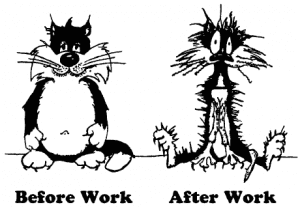 Welcome to part four of the series on understanding stress. In the first three segments I talked about the various kinds of stress people in high risk jobs can experience. For seasoned veterans, the information shared likely served as a good review. For newer members, it may have alerted you to the stressors that may challenge your situational awareness.
Welcome to part four of the series on understanding stress. In the first three segments I talked about the various kinds of stress people in high risk jobs can experience. For seasoned veterans, the information shared likely served as a good review. For newer members, it may have alerted you to the stressors that may challenge your situational awareness.
For the balance of this series I am going to address the cognitive ill-effects of stress on decision making. This is where the proverbial ‘rubber meets the road.’ If the previous installments were in the nice to know category, the upcoming segments are in the critical to know category. Let’s talk hyper vigilance.
What in tarnation is hyper vigilance? Is it a good thing or a bad thing? Should you have or should you avoid it? What in tarnation is tarnation? So many questions, so little time. Let’s jump in.
Hyper Vigilance
 Hyper vigilance is a biological response to stress that causes your senses to go on high alert for danger. Like NORAD in a DEFCON 2 alert status in the movie War Games, your body goes on super alert status because it senses there is danger in the area. The hormones trigger biological changes that increase the acuity of your senses.
Hyper vigilance is a biological response to stress that causes your senses to go on high alert for danger. Like NORAD in a DEFCON 2 alert status in the movie War Games, your body goes on super alert status because it senses there is danger in the area. The hormones trigger biological changes that increase the acuity of your senses.
Stated another way, hyper vigilance can help your eyes see things that they might not have otherwise seen if you were not under stress. Likewise, hyper vigilance can help your ears hear things that they might not have otherwise heard if you were not under stress. And, for the sake of avoiding the annoyance of being repetitive, suffice it to say that all your senses are equally hyper aroused and on high alert. The stress of an emergency scene leads your brain to think there is danger in the area which makes your thinking (and in some cases your actions) primal.
Primal Goal #1: Survive!
 The goal of the body and brain in a stress-induced, hyper aroused state is simple. Survive. What is out there that can kill you? Can you kill it? Can you outrun it? Those are the questions your brain is grappling with and your alert senses will help it make that determination. The human body is well-suited (based on genetic adaptation) to deal with these short-term stressors.
The goal of the body and brain in a stress-induced, hyper aroused state is simple. Survive. What is out there that can kill you? Can you kill it? Can you outrun it? Those are the questions your brain is grappling with and your alert senses will help it make that determination. The human body is well-suited (based on genetic adaptation) to deal with these short-term stressors.
It was that kind of stress your cave-dwelling ancestors dealt with every day. Eat or be eaten. It was a pretty simple existence out there on the Serengeti. There were no worries about 401k plans, bad economies, looming mortgage  payments or kids not doing well in school. The stresses of your daily lives are very different and in many ways (as I had discussed in Part 2 of this series) far more chronic and cumulative. On the upside, you don’t have to worry about a T-rex eating your kids when they leave the house.
payments or kids not doing well in school. The stresses of your daily lives are very different and in many ways (as I had discussed in Part 2 of this series) far more chronic and cumulative. On the upside, you don’t have to worry about a T-rex eating your kids when they leave the house.
So we’ve established it. Hyper vigilance is a good thing! Well, don’t pop the Champagne corks yet. We’re not done.
The downside of hyper vigilance
Your brain is a wonderment of science, that is for certain. It can do things that no computer can duplicate. But it does have some limitations. One of those limitations is how much information it can take in, process, comprehend and recall at any one time. That question of just how much information that is intrigued the research community and in 1956 a cognitive psychologist at Princeton University named George Miller provided the shocking answer.
Seven. The average person can hold about seven pieces of information in working (short term) memory, give or take two (for those slightly above and slightly below average performers). Miller’s studies have been robustly confirmed in numerous studies since. Coincidentally, it was the results of Miller’s research that led to the original seven-digit telephone numbering system.
This is where hyper vigilance can turn ugly in a hurry. Because your senses are hyper aroused, they are taking in more information about your surroundings. If your  surroundings are simple and basic (like fighting a saber-toothed tiger in the jungle of the East Savannah (as your cave-dwelling ancestors did), then you didn’t have to worry about your brain getting overwhelmed with information.
surroundings are simple and basic (like fighting a saber-toothed tiger in the jungle of the East Savannah (as your cave-dwelling ancestors did), then you didn’t have to worry about your brain getting overwhelmed with information.
But, put that brain on an emergency scene with dozens, maybe even hundreds of pieces of data coming at you and you are on the fast-track for overload. Some the data is in writing, some audible, most is visual and nearly all of it is changing rapidly. It is easy to get overwhelmed in a hurry.
Dr. Gasaway’s Advice
 The solution to this problem was uncovered during the research conducted by cognitive psychologist Gary Klein, also known for his discovery of the Recognition-Primed Decision Making Process. Klein’s research involved trying to understand the decision making processes used by fireground commanders. One of the questions to be answered was: How do you make sense of it all? How do you process and comprehend so many clues and cues?
The solution to this problem was uncovered during the research conducted by cognitive psychologist Gary Klein, also known for his discovery of the Recognition-Primed Decision Making Process. Klein’s research involved trying to understand the decision making processes used by fireground commanders. One of the questions to be answered was: How do you make sense of it all? How do you process and comprehend so many clues and cues?
The answer was a stunner and entirely unexpected. The expert-level fireground commanders said they don’t try to process and comprehend all the information. In fact, there is just a small number of critical pieces of information essential for making a good decision. Commanders noted if they tried to comprehend it all, it would be impossible.
So what should be on the short list for critical information to capture and process? Obviously the answer would vary for each type of emergency you deal with. For residential dwelling fires I wrote about this previously so instead of rehashing it, I’ll simply make this sentence a clickable link to that article.
The take-away lesson is: Stress causes hyper vigilance which increases your acuity. In a complex, fast-paced environment, that can accelerate cognitive overload. Less information, so long as it’s the right information, is your best ally. There are a couple more caveats about the information. The more complex the information, the more likely you are to be overwhelmed. The more detailed the information is, the more likely you are to be confused. And the more unfamiliar the information is, the more time you will need because you have to learn what the information means.
 Action Items
Action Items
1. Pick a type of emergency (other than the residential structure fire that I have spoken about) and detail the 7 (or less) critical pieces of information you think are essential to making a good decision.
2. What tricks and secrets do you have for managing information in complex environments? (Here’s a hint… I’ve written about some of them).
3. Describe a situation where you realized, maybe even after the fact, that your senses were hyper vigilant and you heard or saw things that you might not have otherwise seen or heard.
About the Author
Richard B. Gasaway, PhD, CSP is widely considered a trusted authority on human factors, situational awareness and the high-risk decision making processes used in high-stress, high consequence work environments. He served 33 years on the front lines as a firefighter, EMT-Paramedic, company officer, training officer, fire chief and emergency incident commander. His doctoral research included the study of cognitive neuroscience to understand how human factors flaw situational awareness and impact high-risk decision making.
_____________________________________________________

If you are interested in taking your understanding of situational awareness and high-risk decision making to a higher level, check out the Situational Awareness Matters Online Academy.
CLICK HERE for details, enrollment options and pricing.
__________________________________
Share your comments on this article in the “Leave a Reply” box below. If you want to send me incident pictures, videos or have an idea you’d like me to research and write about, contact me. I really enjoy getting feedback and supportive messages from fellow first responders. It gives me the energy to work harder for you.
Let’s Get connected
Facebook: SAMatters
LinkedIn: Rich Gasaway
LinkedIn: Situational Awareness Matters
Twitter: Rich Gasaway
Youtube: SAMattersTV
itunes: SAMatters Radio
Stitcher Radio: SAMatters Radio
Google Play: SAMatters Radio
iHeart Radio: SAMatters Radio


Pingback: Stress: The Nemesis of Situational Awareness | Situational Awareness Matters!™
Hi Rich,
Completely agree with your article. I have always found it is best to categorise information or data into one of 7 sections/considerations for Incident Management. I wrote a brief explanation on
http://www.linkedin.com/groups/Implementing-Effective-Incident-Management-Structures-4574223.S.146922899?qid=544492cf-6e53-4b45-b66a-e77efd7678e1&trk=group_most_popular-0-b-ttl&goback=%2Egmp_4574223
By doing this I always felt that I was processing data and “storing” it in the right section as part of an overall structure.
I’d welcome your thoughts on this.
Ben
Ben,
Thanks for sharing your article. Good stuff. I hope everyone reads it.
Rich
When I was younger I used to hear a voice telling me what to do in an emergency situation. I now understand this is my self-speak. At 66 years of age, two heart attacks and diabetes, along with several neurological problems I no longer hear the voice. I see what is happening and I now respond to the situation without having any conscious thought. My response is extremely fast. What is your thought on this?
That is a difficult question to answer as you acknowledge the presence of a significant medical history that includes the potential for an altered neurological state. As time passes and we develop a great collection of life’s experiences, we tend to be quicker at assessing problems and offering plausible and accurate solutions through pattern matching. It may simply be you’re better at drawing on past experiences to make rapid responses. But, in complete honesty, this is merely speculation based on VERY limited information provided to me.